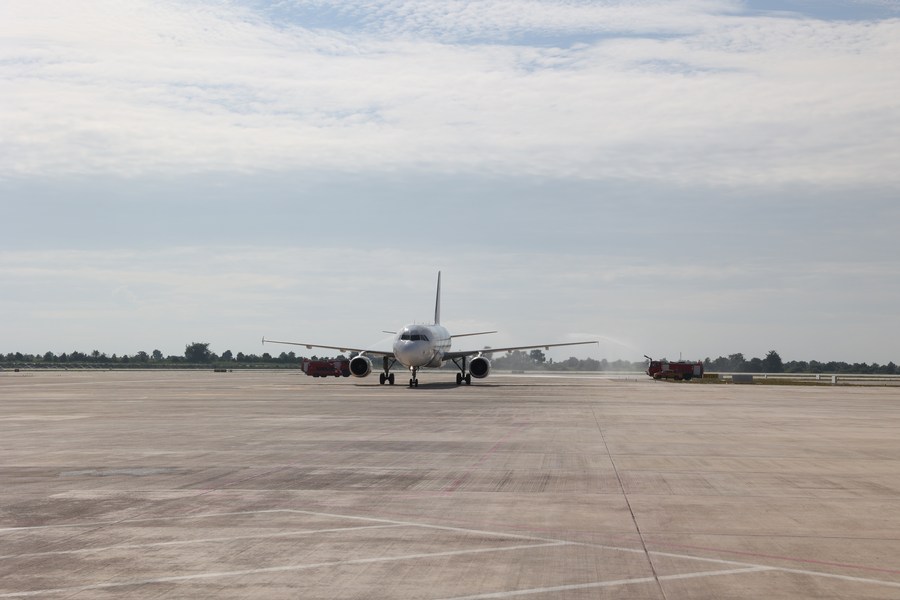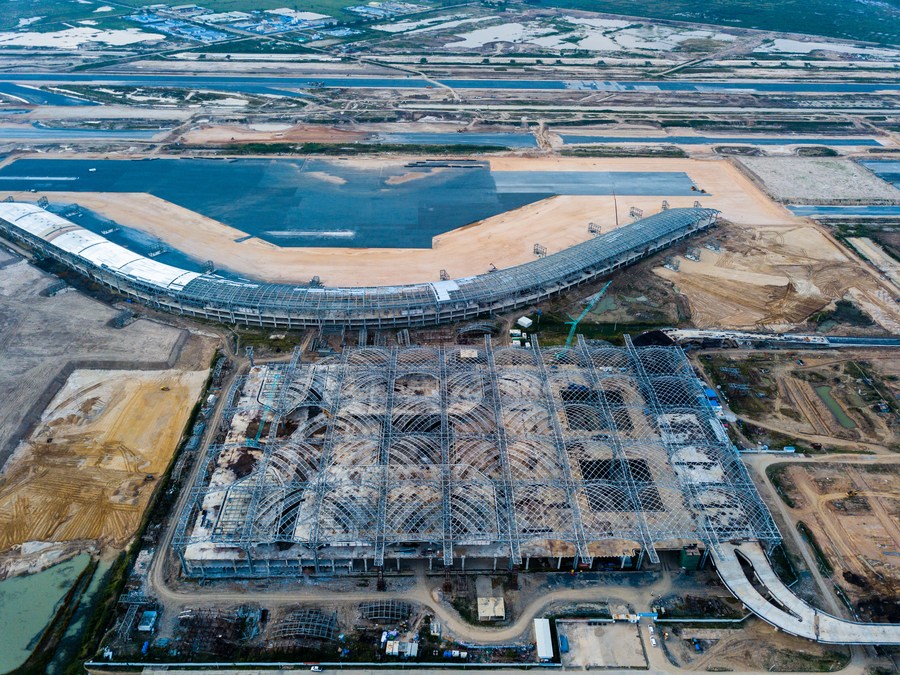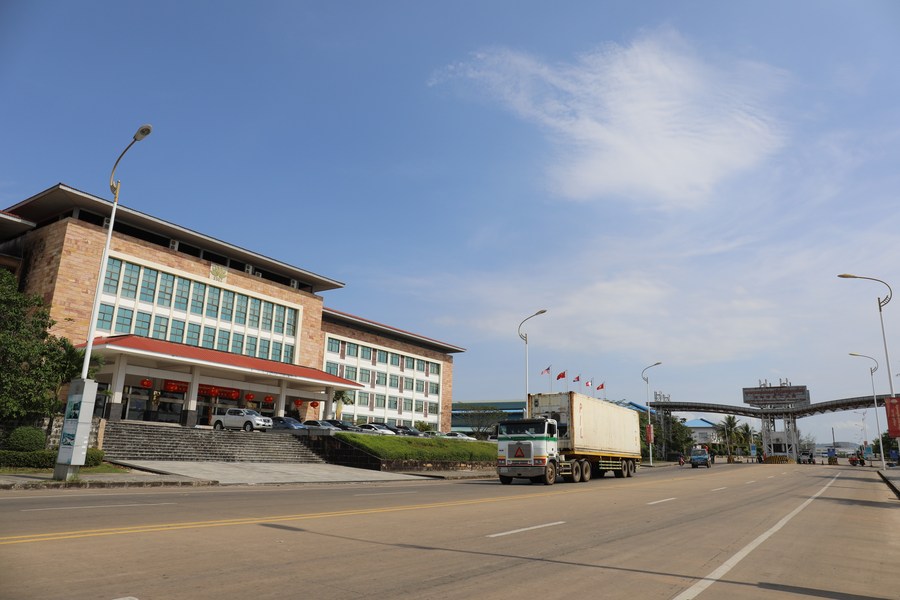Decade-old BRI becomes catalyst for economic growth, prosperity: Cambodian experts

A Bangkok Airways flight arrives at the Chinese-invested Siem Reap Angkor International Airport (SAI) in Siem Reap province, Cambodia on Oct. 16, 2023.(Angkor International Airport Investment (Cambodia) Co., Ltd./Handout via Xinhua)
The BRI is not just an infrastructure project; it's a testament to the power of international cooperation, connectivity, and shared aspirations, says Neak Chandarith, director of the Cambodia 21st Century Maritime Silk Road Research Center.
PHNOM PENH, Oct. 26 (Xinhua) -- The decade-old Belt and Road Initiative (BRI) proposed by China has become a catalyst for regional and global economic growth and property, Cambodian experts said here on Wednesday.
Neak Chandarith, director of the Cambodia 21st Century Maritime Silk Road Research Center, said the BRI is not just a framework for infrastructure development, it's a catalyst for economic progress and prosperity.
"It has been a catalyst for economic growth, cultural exchange, and diplomatic collaboration on a global scale," he said at the second Phnom Penh Forum, hosted by the International Relations Institute of Cambodia, a think tank under the Royal Academy of Cambodia.
"It is a vision for a better-connected world," he added.
Chandarith said the BRI is not just an infrastructure project, it's a testament to the power of international cooperation, connectivity, and shared aspirations.
"It has ushered in an era of economic growth, promoting trade, investment, and infrastructure development," he said. "The initiative's cultural exchange programs and diplomatic collaborations have nurtured an atmosphere of shared humanity, mutual respect, and intercultural dialogue."
The BRI consists of the Silk Road Economic Belt and the 21st Century Maritime Silk Road. It was initiated by China in 2013 to build trade and infrastructure networks connecting Asia with Europe and Africa on and beyond the ancient Silk Road trade routes.

This aerial photo taken on Nov. 8, 2022 shows the construction site of the new Phnom Penh international airport in Kandal province, Cambodia. (Xinhua/Zhu Wei)
Chandarith said the BRI's infrastructure projects such as roads, bridges, railways, ports, airports, and telecommunications systems have not only bridged regional gaps, but also improved transportation efficiency and facilitated the flow of goods and services.
He added that the initiative has promoted economic integration among participating countries, striving to break down trade barriers, streamline customs procedures, and create a more open and inclusive trading environment.
"The BRI has created opportunities for businesses, stimulated economic growth, and encouraged cross-border trade," he said. "It has become a symbol of unity, inclusivity, and shared prosperity."
For Cambodia, the expert said the BRI has brought forth infrastructure development projects that have improved transportation networks, attracted foreign investment, and boosted trade.
"These developments have the potential to spur economic diversification, create jobs, and alleviate poverty, empowering communities and improving the quality of life for millions of people," he said.
Chandarith said thanks to the BRI, Cambodia has also seen the establishment of two significant airports, namely the Siem Reap Angkor International Airport and the new Phnom Penh International Airport, the Phnom Penh-Sihanoukville Expressway, and the Sihanoukville Special Economic Zone, which are transforming the economic landscape of the Southeast Asian country.
"The two new international airports are pivotal in improving air connectivity, not only facilitating tourism but also enabling smoother trade and business interactions," he said. "Furthermore, the establishment of special economic zones and industrial parks are encouraging foreign investment and industrial development."

This aerial photo taken on Oct. 28, 2022 shows the Phnom Penh-Sihanoukville (PPSHV) Expressway in Preah Sihanouk Province, Cambodia.(PPSHV Expressway/Handout via Xinhua)
Joseph Matthews, a senior professor at the BELTEI International University in Phnom Penh, said the BRI has provided enormous opportunities for international cooperation, contributing to sustainable and high-quality development in countries along the Belt and Road in the areas of transport infrastructure, renewable energy, green finance, digital connectivity, and healthcare, among others.

Photo taken on July 19, 2022 shows the entrance of the Sihanoukville Special Economic Zone (SSEZ) in Preah Sihanouk province, Cambodia.(SSEZ/Handout via Xinhua)
"The BRI has opened new doors of opportunities, infrastructure development, innovation, and connectivity through digital and technological cooperation, and creating job opportunities for youths of the region," he said at the forum.
"For Cambodia, BRI projects have not created a debt trap at all because most of the projects here have been developed under the form of Build-Operate-Transfer," he said. "Moreover, Cambodia's total public debt is still far below the threshold of 40 percent."
- Cambodian villagers celebrate upcoming Chinese New Year
- Feature: Colorful cultural event held in Cambodia to celebrate upcoming Chinese New Year
- China key importer of Cambodia's agricultural products: spokesperson
- Chinese firm starts to build car tire plant in SE Cambodia
- Guest Opinion: BRI boosts socio-economic development in Cambodia and beyond


